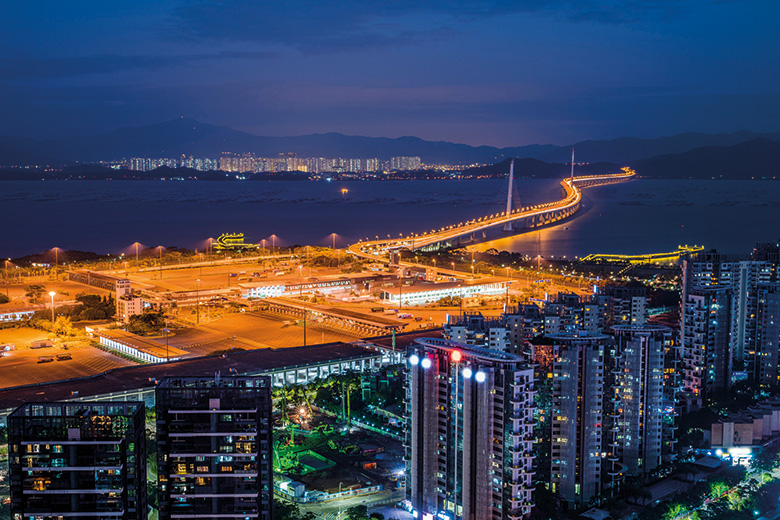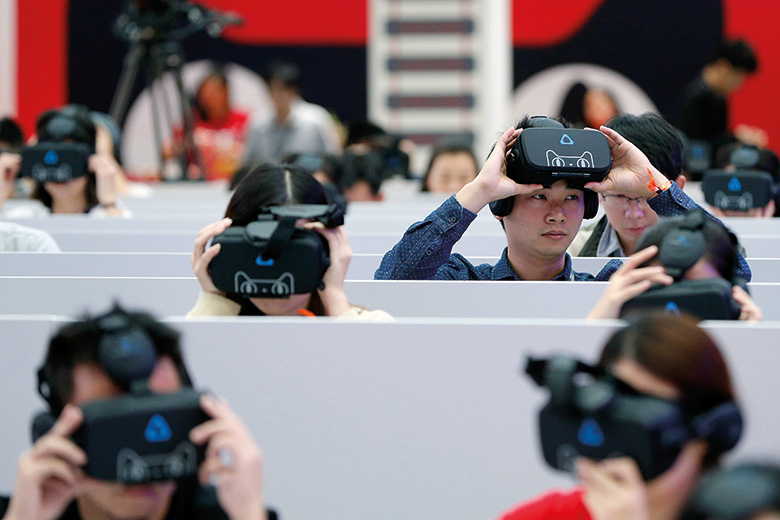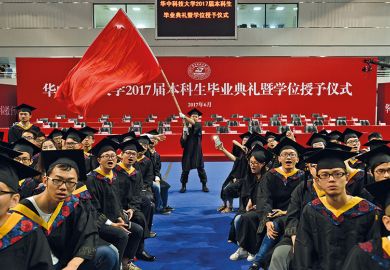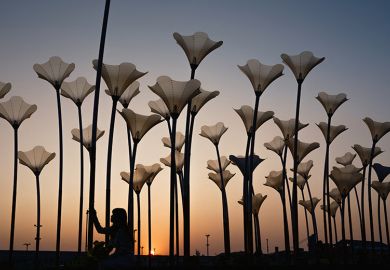With thousands of packages from Alibaba and other online retailers filling its shelves, the mailroom of Shenzhen’s newest university has had to resort to piling its parcels outside on the pavement.
“This is a very typical sight for a Chinese university,” says Zeran Lai, a first-year undergraduate at the Southern University of Science and Technology (SUSTech), as students sift through the metre-high mountain of post in search of their latest purchase. In the days after China’s “Singles Day” on 11 November – an online shopping extravaganza spread by students in the 1990s that is now four times as big as Black Friday in the US – the mountain sometimes grew five times larger, adds Lai, who plans to major in aerospace engineering after he has completed the broad foundation curriculum in science, engineering, technology and mathematics that all SUSTech students follow for their first two years.
Unusual postal arrangements are not the only eye-catching aspect of student life at SUSTech, located in the forested suburbs of Shenzhen, a city of 12 million people in south China, just over the border from Hong Kong.
Outside the main student canteen are at least 1,000 neatly ordered bicycles, of which most are bright yellow ones that unlock by smartphone (they are owned by the Chinese bike-sharing company Ofo and are now popping up in British cities, too). Bike stations packed with several hundred cycles are also found outside most academic buildings – with dust accumulating on the seats of some app-activated bikes now inoperable after their owners went bust.
Anyone attempting to buy lunch with coins or bills will also be frustrated, for SUSTech is an almost entirely cashless and cardless environment: all transactions are made using a mobile phone app, from buying a boiled egg (Rmb2, about 20p) to paying for a taxi.
Another thing clearly evident at SUSTech, which opened in 2011, is an enormous ambition: it intends to establish itself as a world-class university – and to do so quickly. Large-scale construction on campus is a fairly standard sight across the globe these days, but it is less common to see construction teams still hard at work, under floodlights, at 10pm, and then resuming before 8am the next day. The results are rather aesthetically pleasing, with planners opting to retain a surprisingly high number of mature trees in the midst of a modernist campus that will be capable of accommodating 8,000 students this year, organised into six US-style residential colleges. The pace of construction is such that this figure is almost double the 4,400 who were taught on campus in 2016.
“Things get done in China much quicker than in the West,” says Zhenghe Xu, dean of SUSTech’s new College of Engineering, who returned to China last June after 27 years in US and Canadian academia, including 17 years as a professor at the University of Alberta. “If you want to build a bridge in the West, it will take two years just to get planning permission – in China, it’s done in six months. I sometimes wonder if the pace of change is too fast.”
That pace, however, suits many Chinese-born scientists and engineers who, having spent their entire careers in North America, Europe or Australia, are keen to make a big mark on science, says Xu. “Some scientists with tenure in the US have come here because life is short and they want to accomplish something amazing in Shenzhen.”
In his case, plans for a new 114,000 square metre College of Engineering – about 25 per cent larger than London’s Francis Crick Institute and accommodating some 300 research staff – were approved in May 2017, with a plan for it to open within 888 days. The gigantic investment that it represents is no one‑off at SUSTech, either: there are six other academic schools, and local reports suggest that authorities spent about Rmb8 billion (£900 million) just on relocating homes from its favoured site on the edge of Shenzhen, before investing Rmb10 billion more in the labs, colleges and numerous sports facilities, including basketball and badminton courts, an outdoor swimming pool and an athletics stadium.
However, what is arguably most astonishing about the scale of investment at SUSTech is that the university is not even part of China’s flagship excellence initiative – the Double First-Class project – which has singled out 42 universities to receive special funding so that they can achieve “world-class” status by 2050, according to an announcement in October. Much of the funding for SUSTech comes not from the central administration but rather from the Guangdong provincial government.
Shenzhen was little more than a fishing village 40 years ago, but last year alone it unveiled 17 new skyscrapers. Now it has a larger population than London.
“Any big city should have an established university – Boston has Harvard, San Francisco has Berkeley, and Shenzhen now has SUSTech,” Xu says, neglecting to note that when SUSTech was founded the city was already home to Shenzhen University, with a student count of 34,000. And while that figure might seem like a drop in the ocean in terms of meeting the local appetite for higher education, Xu plans to keep enrolments at SUSTech much lower than even that. Shenzhen is often referred to as “China’s Silicon Valley”, and Xu is determined to emulate Stanford University, famed for its links with the US tech sector. Hence, the institution aims for a total student count of no more than 10,000. Its student-to-faculty ratio of 8 to 1 is already better than that of China’s top two universities, Beijing University (9.5 to 1) and Tsinghua University (11 to 1), according to Xu – but he aims to reduce it to 5 to 1.

SUSTech is yet to feature in THE’s rankings, but was rated 32nd in China in the 2017 Nature Index, which tracks outputs published in 68 top scientific journals in the 12 months up to September 2017. This means that, year-on-year, SUSTech saw the third best improvement of any institution globally, and had the best output per scientist of any Chinese institution, according to Xing Cheng, head of SUSTech’s department of materials science and engineering. But for all SUSTech’s ambitions for global greatness, many doubt that a university built on a greenfield site just seven years ago can really attain “world-class” standing. It might possess the financial firepower, but is that enough to convince globally renowned researchers to move to a relatively unknown Chinese metropolis where English is not widely spoken? Wouldn’t Hong Kong, with its five well-resourced universities in the top 200 of Times Higher Education’s World University Rankings 2018 – be a better bet for those among the 45,000 or so Chinese expatriate scholars in the US who fancy moving closer to home? Or perhaps Beijing’s Tsinghua or Peking universities, both in the global top 30?
One selling point that Shenzhen can offer to academics – beyond its relatively clean air – is that it is the obvious entry point into China’s burgeoning high-tech industries. Technology giants Huawei, ZTE and Tencent – China’s answer to WhatsApp (which is banned, like Google and Facebook, in the country) – are all based in the trade and manufacturing metropolis, whose $350 billion (£278 billion) gross domestic product is set to overtake Hong Kong’s this year.
“Shenzhen is a very dynamic, young and open-minded city,” says Cheng, who was attracted back to China after 16 years in the US by the opportunities for research in microrobotics.
“You can do top research in the US, but it is difficult to communicate with industry; in Shenzhen, there are so many opportunities to work with venture capital funds, both government and private sector,” says Cheng. Half of all patents filed in China come from Shenzhen, he adds.
“Shenzhen is new to the education industry – it was a city that grew too fast, so its higher education provision is lagging behind. But it is catching up,” Cheng explains.
In the department’s main research building, a board displaying photos of the dozen or so principal investigators – all of whom have come from the US, China or Australia – indicates that important fundamental research, albeit with obvious industrial applications, is already under way.
Each of the principal investigators has about 150 square metres of lab space and 10 to 20 researchers, typically funded initially for two to three years. One metallurgy project to produce injection-moulded metals could have massive benefits for Shenzhen’s mobile phone manufacturing industry by creating faster and virtually waste-free methods of producing tiny metal parts, Cheng says. In a nearby building, a spectroscopy project is exploring how different diseases might be detected using infrared analysis of sweat – potentially paving the way for people to self-diagnose using a mobile device, transforming healthcare. That project has been aided by a newly arrived $3 million (£2.2 million) microscope, which Cheng says makes visiting US scientists “very envious”.
More explicit efforts at technology transfer are evident in the university’s College of Innovation and Entrepreneurship, which aims to recruit 200 part-time industry-based adjunct tutors, in addition to 50 full-time research professors and 40 industry-facing academic professors, working primarily with local high‑tech firms.
“Stanford is much discussed,” admits Azalea Zhu Yuan, an associate professor, in conversations about the inspiration for this “iCollege”. While SUSTech’s emphasis remains on fundamental research with an eye on industry, those “who really want to do applied research can join our college and work part-time here”, she says. That approach has helped to lure some genuine US research stars – such as Zhihong Xia, a data scientist who became a full professor in the US aged 29 and who left Northwestern University in 2015 to head SUSTech’s maths department – as well as some Chinese business leaders, such as Pinghui Wang, who was previously vice-president of the China Aerospace Electronics Research Institute.

With SUSTech ramping up its research programme, one might imagine Hong Kong to be somewhat ambivalent about its upstart neighbour’s ambitions. For years, the former British colony has regarded itself as the “value-added” capital of the Pearl River Delta region, leaving the low-skilled metal-bashing to Shenzhen’s nearby factories. But with Shenzhen already overtaking Hong Kong economically, is it possible that it could eventually do so intellectually?
It’s not a scenario that seems to worry university leaders in Hong Kong. According to Andy Hor, vice-president and pro vice-chancellor for research at the University of Hong Kong (HKU), it is not helpful to compare the rapidly rising institutions of mainland China to ones such as HKU, which was established in 1911 and is ranked fifth in Asia and 40th globally by THE.
“Big universities have their own science ecosystems and are huge forces within their city,” he says. “Beijing can give researchers bigger laboratories and more funding…but Hong Kong has other strengths beyond funding.”
One such asset is its international atmosphere, with 40 per cent of HKU faculty hailing from outside Hong Kong or mainland China: “We have staff and students here from all over the world, as well as partners across the globe.” Other pull factors for international academics include a UK-style tenure and promotion system, a mature legal system and Hong Kong’s culture and general quality of life, Hor adds.
So rather than fearing Shenzhen’s rise, he sees it as a wonderful opportunity for both parties. “Going to Shenzhen is almost a must for us,” he says, explaining how his institution has played a central role in the Shenzhen Virtual University Park, which was set up by the local municipal government in 1999 to foster greater university-business interaction. The site now hosts representatives of 57 universities, including seven from overseas, which have used the park as a base to plug into Shenzhen’s tech scene. HKU also has its own research base in Shenzhen, and another in Hangzhou, near Shanghai, allowing it to tap into central Chinese funding while also sharing its expertise.
“It’s a good example of how a partnership can benefit both ourselves and mainland China,” Hor says.
Working with laboratories in Shenzhen and Hangzhou has transformed the working lives of many Hong Kong researchers, says Liqiu Wang, a professor in HKU’s department of mechanical engineering, who travels at least twice a month to the university’s mainland outposts. “It’s a new life – it’s tiring, but I like it,” he says.
Switching between the UK-style system of HKU, whose institutional tartan decorates several walkways ahead of graduation ceremonies, and China’s more regulated environment can be tricky, Wang admits. “But the resources [available] in China are huge because so is the market: there is such eagerness to embrace high-tech products,” he adds. For instance, a waterproof coating developed at HKU – inspired by investigations into what keeps woodlice from becoming saturated when they crawl around in wet mud – has recently been picked up by a leading sportswear manufacturer; Wang hopes to see a product using the material hit the shelves within two years. Meanwhile, a study of the water-retaining properties of a spider’s silk might also soon lead to industrial applications, he adds.
“This work involves biologists, engineers, chemists and physicists – it’s the kind of top interdisciplinary research that only big universities specialise in,” Wang says.
Creating deeper collaborations with the Chinese mainland offers other benefits beyond enhanced research funding and stronger industry collaborations, says W. John Kao, vice-president and pro vice-chancellor (global) at HKU. The university’s 2,000-bed teaching hospital in Shenzhen not only provides cutting-edge treatment in an area underserved by existing provision but also enables HKU medics to further their training and research by gaining insight into the different illnesses found in mainland China, he says. “There are cases that we might see once a month in Hong Kong, but in Shenzhen we see them every day.”
One disease of interest to Kao, who was previously Vilas distinguished achievement professor of pharmacy, surgery and biomedical engineering at the University of Wisconsin-Madison, is a genetic defect known commonly as brittle bone disease. Daily contact with people who have the condition is vital for medical students learning to treat the disease and for researchers studying it, he explains. “In medical training, the more you do something, the better you get, which is why having access to this huge population is so important – it’s really a win-win for us,” he says.

Stepping up interaction with the mainland has also been timely for Hong Kong universities in light of the growing momentum of China’s Belt and Road project. Under the scheme, the country will invest at least £96 billion in the infrastructure of neighbouring countries along its maritime “belt”, such as Vietnam, Indonesia and other Pacific neighbours, as well as along the former Silk Road trading routes, taking in Russia, Turkey and Eastern Europe. Many see the project to create a new economic corridor across Eurasia as China’s attempt to overtake the US as the world’s political and economic superpower.
As the region’s banking hub and the historic Western entry point into Asia, Hong Kong is viewed as a vital part of the project. Shenzhen and Hong Kong combined already have an economic output greater than Taiwan’s; the Pearl River Delta more broadly is expected to overtake the Bay of Tokyo and New York City in economic terms by 2030, experts believe.
“People think of Belt and Road as just building highways and railroads, but there is a lot more to promoting trade,” says Kao. Hong Kong will be particularly important for the education strand of Belt and Road. This element, known as the “Belt and Road Alliance for Industry and Education Collaboration”, was launched in June 2017, and Kao believes that it is essential to improving transnational understanding. Within five years, for instance, all Hong Kong students will be required to undertake a study or work placement in mainland China to help them get an inside view of the different business cultures emerging across the country.
“China is not monolithic – you might know Beijing, but if you go to western China it is very different,” says Kao.
For Rocky Tuan, president of the Chinese University of Hong Kong (CUHK), Hong Kong is the “innovation leader” for the manufacturing and export axis of Belt and Road and will play a huge role in the growth of the Pearl River Delta area. “In terms of finance, law, education and technology, it is the leader, and I don’t worry about this changing,” he adds.
Moreover, he is excited by the opportunities offered by the proximity of Shenzhen to CUHK, which Chinese expatriates set up in 1963 on a campus not far from the border with the aim of offering an alternative to the British model available at HKU. “Shenzhen is really a bit like the Wild West in terms of its growth, but it’s great for CUHK because we have had a long presence there,” Tuan says. In 2012, CUHK set up its own outpost in the city – the Chinese University of Hong Kong, Shenzhen. It has about 3,000 students now but aims to have 11,000 by 2022.
“The goal is not just to have a campus there run by managers from afar, but, by establishing its own board of governors, to create a new university,” says Tuan, who believes that cutting the apron strings at the right time will allow the new institution to thrive.
Other universities in Hong Kong are also strengthening their links to mainland China. In 2011, Hong Kong Polytechnic University (PolyU) established a research base in Shenzhen, which can be reached via a 45-minute train journey from the station adjacent to the polytechnic’s home campus. PolyU has also established five other “regional bases” in collaboration with mainland universities, including in Beijing and Shanghai.
“We have created more than 8,000 graduates on the mainland, who have not needed to come to Hong Kong,” says Timothy Tong, PolyU’s president. But it is clearly the research potential of the university’s growing links with the mainland that most excites him. For instance, a robotic arm built by PolyU was used on a Chinese lunar mission in 2013, he says. Furthermore, “when we have to design equipment that can operate 10,000 miles away, it challenges our researchers to rise up and meet this challenge”, he adds.
The view from the boardroom of its strikingly asymmetrical Zaha Hadid-designed innovation centre, completed in 2014, provides plenty of evidence of PolyU’s ambition. Tong see links with the mainland as crucial to PolyU’s next step up the league tables (it is currently joint 182nd in THE’s World University Rankings), and tapping into China’s vast infrastructure funds is one avenue being explored; a university-designed system that monitors trains for potential faults and has been operating in Hong Kong for 10 years is now being incorporated on the Beijing-Shanghai high-speed line, for instance.

Flitting between Shenzhen and Hong Kong is also standard practice for researchers at the Hong Kong University of Science and Technology (HKUST), says Sabrina Lin, its vice-president for institutional advancement. The two cities are “closer than east and west Beijing, where it takes two hours to cross in traffic”, she says, adding that many of her staff have metro cards for both Shenzhen and Hong Kong – which sometimes leads to comical mix‑ups when they try to travel with the wrong card.
Unlike most Hong Kong university leaders, Lin – a native of the city who has just returned after a career at Stanford – does not rule out the possibility of Shenzhen’s establishing itself as an equal partner on the research front. “No one can predict the future,” she says. “Fifteen years ago, everyone wanted to be in San Jose because of [its proximity to] Silicon Valley – now millennials with start-ups want to be in San Francisco, and labour tends to migrate over time,” she says.
Nevertheless, if Hong Kong keeps making the most of its particular strengths in finance and technology, it will continue to prosper, she adds.
HKUST’s own history shows that a world-class university can indeed be established in a number of years, rather than centuries. Despite having been founded only in 1991, it is now ranked 44th globally, and it could soon overtake HKU in the rankings. Created against the dramatic backdrop of the Sai Kung islands of the South China Sea, the university is home to 15,000 students. It is equipped with Ivy League-levels of sports and social facilities; a new water-sports centre is under construction. However, money alone will not deliver a world-class university, Lin warns. “The reason that top scholars and students want to come here is that they will find like-minded people and an environment conducive to innovation”, in which they can “collaborate both within Hong Kong and with scholars across the world”, she says.
Back in Shenzhen, SUSTech’s leaders are well aware of the challenges ahead. “To be successful as a university, we need money and, more importantly, good people,” Xu says. But “even if we are not in the class of the Hong Kong universities, our quality of faculty is [already] very high”.
Recruitment of students, he adds, is also highly selective. “After all, we only need one or two students to create a Facebook or a Google, and [then] we will have a great reputation.”
POSTSCRIPT:
Print headline: Dreams of instant empire
Register to continue
Why register?
- Registration is free and only takes a moment
- Once registered, you can read 3 articles a month
- Sign up for our newsletter
Subscribe
Or subscribe for unlimited access to:
- Unlimited access to news, views, insights & reviews
- Digital editions
- Digital access to THE’s university and college rankings analysis
Already registered or a current subscriber?







